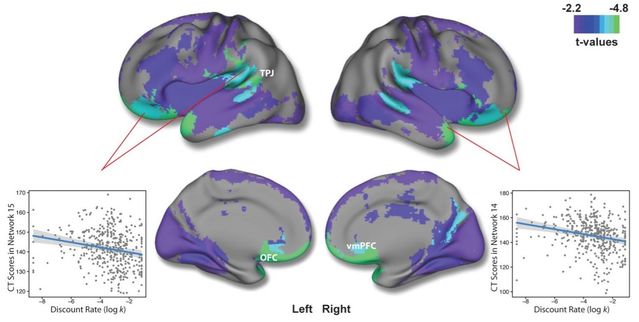Decision-Making
The Neuroscience of Adolescent Impulsivity
Cortical thickness offers insights into teenagers' impulsive decision-making.
Posted February 13, 2018

A new study reports that human youths with a thinner cortex in distinct brain regions are more impulsive during a decision-making task in relation to age-matched peers with a thicker cortex. These findings were published February 12, 2018, in the Journal of Neuroscience.
This study, "Diminished Cortical Thickness Is Associated with Impulsive Choice in Adolescence," by researchers from the Philadelphia Neurodevelopmental Cohort (PNC) corroborates previous research on adults, which found that having less cortical thickness is linked to a preference for smaller, instantaneous rewards instead of larger, delayed rewards.
Would you rather receive a small reward now, or a bigger reward later?
"Delay discounting" is a term used to describe someone’s tendency to decrease the value of a reward depending on how long it takes to be rewarded. In this study, varying degrees of delay discounting were measured by giving participants a hypothetical choice to receive a small amount of money immediately or a more lucrative payout in six months. Those who could delay instant gratification for a bigger reward in six months were viewed as being less impulsive.
For this study on adolescents and impulsivity, Marieta Pehlivanova, Joseph Kable, Theodore Satterthwaite and colleagues at the University of Pennsylvania analyzed behavioral and neuroimaging data collected from a large sample of 208 males and 219 females (ages 9.3-24.3). Their objective was to identify if a correlative relationship between cortical thickness and delay discounting preferences (impulsivity) was observable at a period of teenage brain development marked by significant structural changes.
This correlational study does not identify causation but does suggest that a thinner cortex is associated with a greater degree of impulsivity in adolescence. Cortical thickness also predicted teens' impulsive decision-making and delay discounting preferences beyond other cognitive and demographic variables.
The authors sum up the significance of this study in the abstract: “Notably, the strongest association between impulsive choice and brain structure was seen in regions implicated in value-based decision-making; namely, the ventromedial prefrontal and orbitofrontal cortices. Moving forward, such neuroanatomical markers of impulsivity may aid in the development of personalized interventions targeted to reduce risk of negative outcomes resulting from impulsivity during adolescence.”
References
Marieta Pehlivanova, Daniel H. Wolf, Aristeidis Sotiras, Antonia Kaczkurkin, Tyler M. Moore, Rastko Ciric, Philip A. Cook, Angel Garcia de La Garza, Adon Rosen, Kosha Ruparel, Anup Sharma, Russell T. Shinohara, David R. Roalf, Ruben C. Gur, Christos Davatzikos, Raquel E. Gur, Joseph W. Kable and Theodore D. Satterthwaite. "Diminished Cortical Thickness Is Associated with Impulsive Choice in Adolescence." Journal of Neuroscience (Published: February 12, 2018) DOI: 10.1523/JNEUROSCI.2200-17.2018


